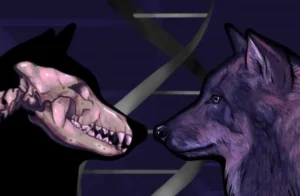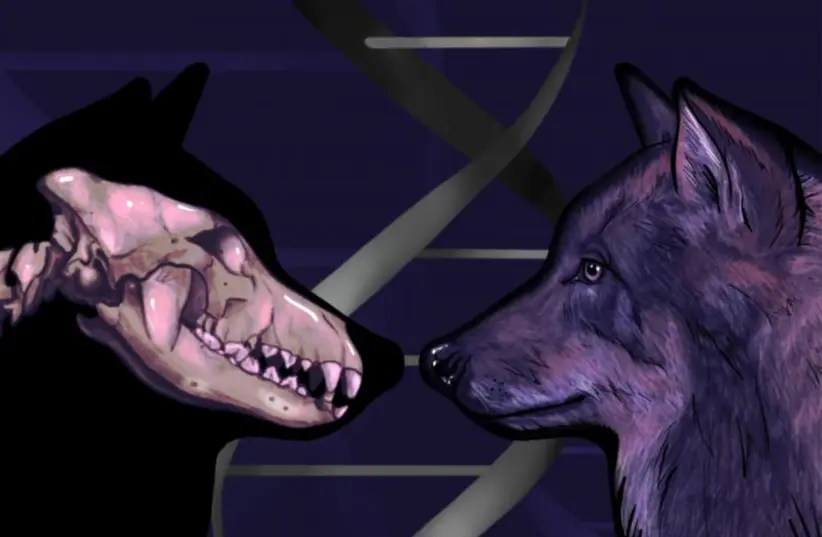Similar whole-genome time series from the Ice Age, in humans or other animals, could provide new information about how evolution happens.

For over 100,000 years, the majestic gray wolf, whose scientific name is canis lupus, has roamed throughout the northern hemisphere, and, unlike other large mammals, did not go extinct in the Late Pleistocene – the Last Ice Age which began some 2.6 million years ago and ended around 11,700 years ago.
Now in a recent study published in the journal Nature, an international group of geneticists and archeologists led by the Francis Crick Institute in London, said their analysis of 72 ancient wolf genomes spanning the last 100,000 years from Europe, Siberia and North America, has shown that the ancestry of modern-day dogs can be traced to two populations of those ancient wolves.
The researchers say their study provides one more step in uncovering the mystery of where wolves underwent domestication to become so integral as work and social companions to humans.
Though it has long been known that dogs originated from the gray wolf at some point at least 15,000 years ago during the Ice Age, the question of where this happened and whether it was a single-place occurrence or took place in multiple locations has remained unanswered.
“While it is clear that gray wolves gave rise to dogs, there is no consensus regarding when, where and how this happened,” the researchers noted in their study.

The team of archaeologists from 38 institutions in 16 countries used remains from previously excavated ancient wolves including a full, perfectly preserved head from a Siberian wolf that lived 32,000 years ago and the fully preserved body of “Dogor,” an 18,000-year-old wolf puppy from Yakutia—also known as the Republic of Sakha which is in the Russian Far East along the Arctic Ocean, according to a press statement from the Crick Institute.
Nine different ancient DNA labs then collaborated on generating DNA sequence data from the wolves.
What they found, the researchers said in their paper, is that dogs are more closely related to ancient wolves from eastern Eurasia than to those from western Eurasia, suggesting that the domestication process took place in the east.
However, they added that they also found that dogs in the Near East – an area that roughly includes the eastern shores of the Mediterranean Sea and encompasses the area of the historical Fertile Crescent and the Levant region – derive up to half of their ancestry from a separate distinct population related to modern southwest Eurasian wolves.
This could indicate another, separate domestication process, or that early dogs still mixed with wild wolves, they said. However, because none of the analyzed ancient wolf genomes is a direct match for either of these dog ancestries, the exact ancestor populations remain to be located, they said in their report.
“By trying to place the dog piece into this picture, we found that dogs derive ancestry from at least two separate wolf populations – an eastern source that contributed to all dogs and a separate more westerly source, that contributed to some dogs,” noted Anders Bergström, co-first author and post-doctoral researcher in the Ancient Genomics lab at the Crick Institute, in the press statement.
In their paper, the researchers noted that subsequently, it was the Western ancestry that spread worldwide with the prehistoric expansion of agriculture in western Eurasia and the colonial era expansion of European dogs.
In addition, Bergström said in the statement, the genome project has greatly increased the number of sequenced ancient wolf genomes, allowing the researchers to create a more detailed picture of wolf ancestry over time including around the time of the dog origins.
As the 72 ancient wolf genomes spanned around 30,000 generations, it was possible to look back and build a timeline of how wolf DNA has changed, tracing natural selection in action, said the researchers.
For example, they observed that over a period of around 10,000 years, one gene variant went from being very rare to being present in every wolf, and is still present in all wolves and dogs today. The variant affects a gene, IFT88, which is involved in the development of bones in the skull and jaw. It is possible that the spread of this variant could have been driven by a change in the types of prey available during the Ice Age, giving an advantage to wolves with a certain head shape, but the gene could also have other unknown functions in wolves, they noted in the statement.
“This is the first time scientists have directly tracked natural selection in a large animal over a time-scale of 100,000 years, seeing evolution play out in real-time rather than trying to reconstruct it from DNA today,”
Pontus Skoglund
“This is the first time scientists have directly tracked natural selection in a large animal over a time-scale of 100,000 years, seeing evolution play out in real-time rather than trying to reconstruct it from DNA today,” said Pontus Skoglund, senior author and group leader of the Ancient Genomics lab at the Crick Institute in the statement. “We found several cases where mutations spread to the whole wolf species, which was possible because the species was highly connected over large distances. This connectivity is perhaps a reason why wolves managed to survive the Ice Age while many other large carnivores vanished.”
Similar whole-genome time series from the Ice Age, in humans or other animals, could provide new information about how evolution happens, he suggested.
The study also showed that all present-day North American wolves can be modeled as having 10%–20% coyote ancestry and the remaining ancestry from Siberian wolves younger than 23,000 years ago, with no contribution from earlier North American wolves, they said in their paper.
Wolves in history, folklore
Wolves featured prominently in many ancient folktales, and in the Roman foundation myth, the wolf goddess Lupa nursed and sheltered the twins Romulus and Remus after they were ordered thrown to the wild by their uncle the mythical King Amulius of Alba Longa. Romulus went on to become founder and first king of Rome. The image of Lupa suckling the twins has been a symbol of Rome since ancient times.
In indigenous Native American tradition, wolves are still seen as sacred creatures, embodying courage, strength and loyalty, sometimes even called brothers.
But while domesticated dogs went on for the most part to become the trusted and pampered companions of humans – putting aside for the moment the incidents of abuse and mistreatment against them which still abounds – their ancestors did not fare so well, and in some places even hunted to extinction.
With the rise of agriculture conflict between humans and wolves grew, and in European folktales – such as Little Red Riding Hood and The Three Little Pigs – the wolf was depicted as evil and dangerous.
According to the World Wide Fund for Nature (WWF), once the most widely geographically distributed mammal, the gray wolf’s range has been reduced by one-third and they are commonly killed out of fear of attacks on humans or in revenge after they kill livestock because ranches are encroaching on their natural hunting grounds.
In the meantime, the multi-national team is continuing their hunt for a close ancient wolf ancestor of dogs, which could reveal more precisely where domestication most likely took place. They are now focusing on genomes from other locations not included in this study, including more southerly regions.

